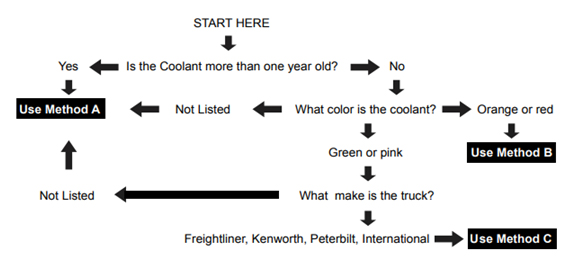99.009: Converting New Trucks to the Fill-For-Life Program
Introduction:
To cost-effectively convert existing heavy-duty truck cooling systems to Fill-For-Life, Penray has identified three possible procedures that can be followed. These recommendations will help customers minimize the initial cost of the upgrade.
Recommendations:
The flowchart will help easily identify the best conversion procedure:

Method “A”:
Drain and flush the cooling system with water until clear. Dispose of the old coolant properly
- Warning: Never open a hot cooling system!
- With the cooling system cool, open the stopcock and remove the thermostat. Drain the coolant, catching it for recycling or proper disposal.
- Flush the system with tap water until clear. Drain the water. Replace the thermostat and close the stopcock.
Fill the system with a properly prepared Fill-For-Life approved coolant (see bulletin 01.001)
- Mix 50% to 60% approved coolant and water -or- in temperate climates (-10 freeze point acceptable) 33% approved coolant, 1% Pencool® 3000 and 66% water -or- in warm climates (+32 freeze point acceptable) mix 5% Pencool 2000 or Pencool 3000 and water. Water needs to be relatively pure, as published in the Penray Cooling System TechFacts.
- Fill the cooling system with the coolant, check to insure correct freeze point and nitrite concentration with a Penray test strip.
Install Need-Release® filter.
- Label the filter with the date and mileage at installation.
- Install the filter hand tight. Do not use a filter wrench.
- Close and pressure-test the system.
Method “B”:
- Convert the organic system to Fill-For-Life technology
- Warning: Never open a hot cooling system!
- With the cooling system cool, open the radiator cap and add 1 pint Pencool 3000 per 4 gallons of cooling system capacity.
- If necessary, top-up the cooling system with a properly prepared Fill-For-Life approved coolant (see bulletin 01.001).
- a. Mix 50% to 60% approved coolant and water -or- in temperate climates (-10 freeze point acceptable) mix 33% approved coolant, 1% Pencool 3000 and 66% water -or- in warm climates (+32 freeze point acceptable) mix 5% Pencool 2000 or Pencool 3000 and water. Water needs to be relatively pure, as published the Penray Cooling System TechFacts
- b. Run the engine 30 minutes to mix the coolant, let the system cool, then check to insure correct freeze point and nitrite concentration with a Penray test strip.
- Install Need-Rekease Filter
- Warning: Never open a hot cooling system!
- Mix 50% to 60% approved coolant and water -or- in temperate climates (-10 freeze point acceptable) mix 33% approved coolant, 1% Pencool 3000 and 66% water -or- in warm climates (+32 freeze point acceptable) mix 5% Pencool 2000 or Pencool 3000 and water. Water needs to be relatively pure, as published the Penray Cooling System TechFacts.
- Run the engine 30 minutes to mix the coolant, let the system cool, then check to insure correct freeze point and nitrite concentration with a Penray test strip.
Method “C”:
- If necessary, top-up the cooling system with a properly prepared Fill-For-Life approved coolant (see bulletin 01.001).
- Warning: Never open a hot cooling system!
- Mix 50% to 60% approved coolant and water -or- in temperate climates (-10 freeze point acceptable) mix 33% approved coolant, 1% Pencool 3000 and 66% water -or- in warm climates (+32 freeze point acceptable) mix 5% Pencool 2000 or Pencool 3000 and water. Water needs to be relatively pure, as published the Penray Cooling System TechFacts.
- Run the engine 30 minutes to mix the coolant, let the system cool, then check to insure correct freeze point and nitrite concentration with a Penray test strip.
- Install Need-Release filter.
- Label the filter with the date and mileage at installation.
- Install the filter hand tight. Do not use a filter wrench.
- Close and pressure-test the system.
Refer to technical bulletin 01.007 for long-term maintenance recommendations of Fill-For-Life systems.
